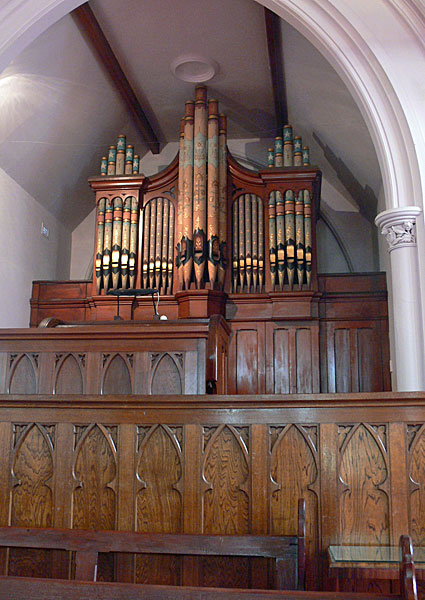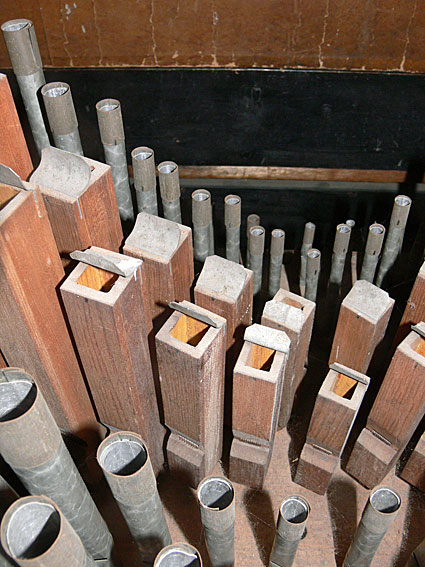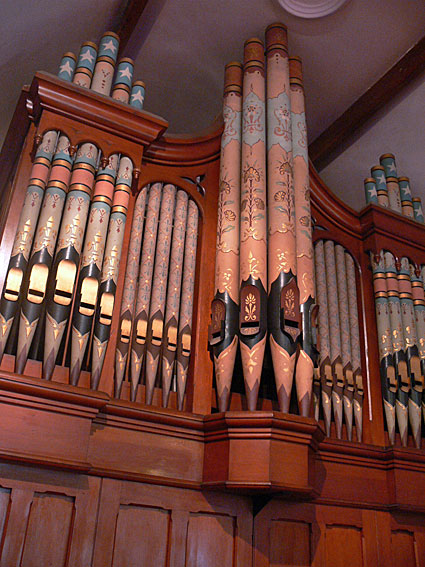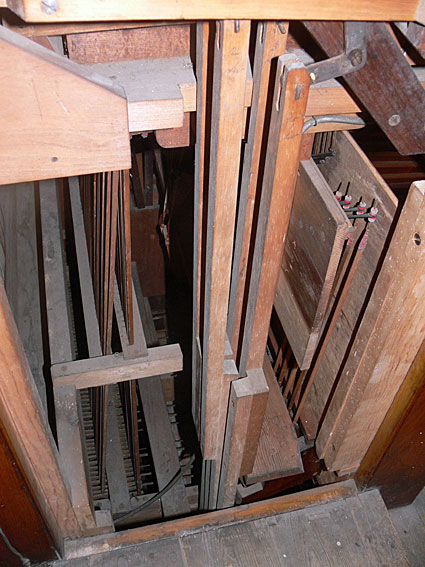St Kilda Parish Mission, Balaclava : the exterior façade
[photograph by John Maidment (7 August 2012)]
Historical and Technical Documentation by John Maidment
© OHTA, 2012 (last updated August 2012)
St Kilda Parish Mission, Balaclava : the exterior façade
[photograph by John Maidment (7 August 2012)]
Historical and Technical Documentation by John Maidment
© OHTA, 2012 (last updated August 2012)
The church was designed by noted architects Crouch & Wilson and built in polychrome brickwork in the Gothic style. The opening of the building in 1877 was reported as follows:
A new church has recently been built at Balaclava to serve the wants of the members of the Wesleyan denomination residing in the district. The building is a neat and compact structure in the early decorated Gothic style. It is built of brick and is surmounted by an elegant spire 80ft in height. The internal dimensions are 45 by 28ft, and sittings have been provided for 200 persons. The architects were Messrs Crouch and Wilson, and the building operations were superintended by Mr W.B. Davies contractor. The opening of the church was celebrated last evening by a tea and public meeting at which there was a large attendance of the members and adherents of the congregation. The chair was occupied by the Hon Alex Fraser, M L C. …1
It was estimated that the building had cost about £1100.

St Kilda Parish Mission, Balaclava: the exterior façade at the time of opening
[photograph of engraving from Illustrated Australian News (5 August 1878)]
In 1885, the size of the church was greatly increased through the addition of transepts and an 'orchestra':
From a perspective view of the church hanging in one of the lobbies, it appears that the additions will more than double the size of the church accommodation, besides providing vestries and orchestra to the church, and infants' classroom, secretary's vestry, and other conveniences to the school. The new work will be in harmony with the existing buildings; the church portion in brick, with dressings in white brick and patent freestone. The orchestra, commencing on the same level as the minister's platform, will rise a few feet higher at the back. Instead of the usual pulpit, a handsome lectern of polished brass, with polished cedar bookboard, will be adopted, supported on either side by handsome brass standard gasoliers. The cost of the work is put down at £1,700, towards which about 1000 has been promised. Mr T.J. Crouch is the architect in charge, and Mr Edmund the contractor for the work.2

St Kilda Parish Mission, Balaclava: the organ
[photograph by John Maidment (7 August 2012)]
The organ was built in 1891 by Fincham & Hobday at a cost of £236. It was opened on 20 August 1891 by G.B. Fentum.3 The instrument has a highly attractive case, with two outer square towers and a central round tower, all containing splendidly decorated pipes, all in original condition. The console is separated from the organ and is constructed from blackwood, with a roll-top cover, scrolled keycheeks and a signature oval nameplate. It is an instrument of the highest quality, all of the metal pipes above 4ft constructed from spotted metal, and notable for its very high level of intactness. The instrument has a bold sound and the Open Diapason is of a very generous scale.

St Kilda Parish Mission, Balaclava: the organ console
[photograph by John Maidment (7 August 2012)]
The organ is of particular note for its extended mechanical action linking the console to the windchests and running in a cellar beneath the floor of the choir seating. This is all very neatly made up in wooden frames and fitted with registers to prevent the trackers from 'whipping'. The building frame of the organ extends downwards to the floor of the cellar and the double-rise reservoir and feeders are placed close to the ground, the wind trunks fitted with anti-concussion bellows. This is all a very rare survival.

St Kilda Parish Mission, Balaclava: wooden action runs and reservoir in the cellar beneath the organ
[photograph by John Maidment (7 August 2012)]
| GREAT Gt: Open Dia Gt: Claribel Gt: Dulciana Gt: Rohrflöte Swell to Great SWELL Sw: Open Dia Sw: Stop Dia Sw: Principal Sw: Oboe PEDAL Ped: Bourdon Great to Pedal Swell to Pedal |
8 8 8 4 8 8 4 8 16 |
gvd.bass gvd.bass |
Compass: 56/30
Mechanical key and stop action
2 composition pedals to Great
Tremulant (later addition, by rocking tablet in Great keycheek)
Balanced swell pedal (in place of original lever pedal)4

St Kilda Parish Mission, Balaclava: left hand stop jamb
[photograph by John Maidment (7 August 2012)]

St Kilda Parish Mission, Balaclava: right hand stop jamb
[photograph by John Maidment (7 August 2012)]

St Kilda Parish Mission, Balaclava: keyboards and Fincham & Hobday nameplate
[photograph by John Maidment (7 August 2012)]

St Kilda Parish Mission, Balaclava: Great pipework
[photograph by John Maidment (7 August 2012)]

St Kilda Parish Mission, Balaclava: façade pipe detail
[photograph by John Maidment (7 August 2012)]

St Kilda Parish Mission, Balaclava: action inside the organ console
[photograph by John Maidment (7 August 2012)]
1 The Argus, 31 May 1877, p.5
2 The Argus, 27 January 1885, p.9
3 E.N. Matthews, Colonial Organs and Organbuilders. Carlton: Melbourne University Press, 1969, p.122 from Fincham letters 7/462, 14/203
4 Specification noted by John Maidment 2012